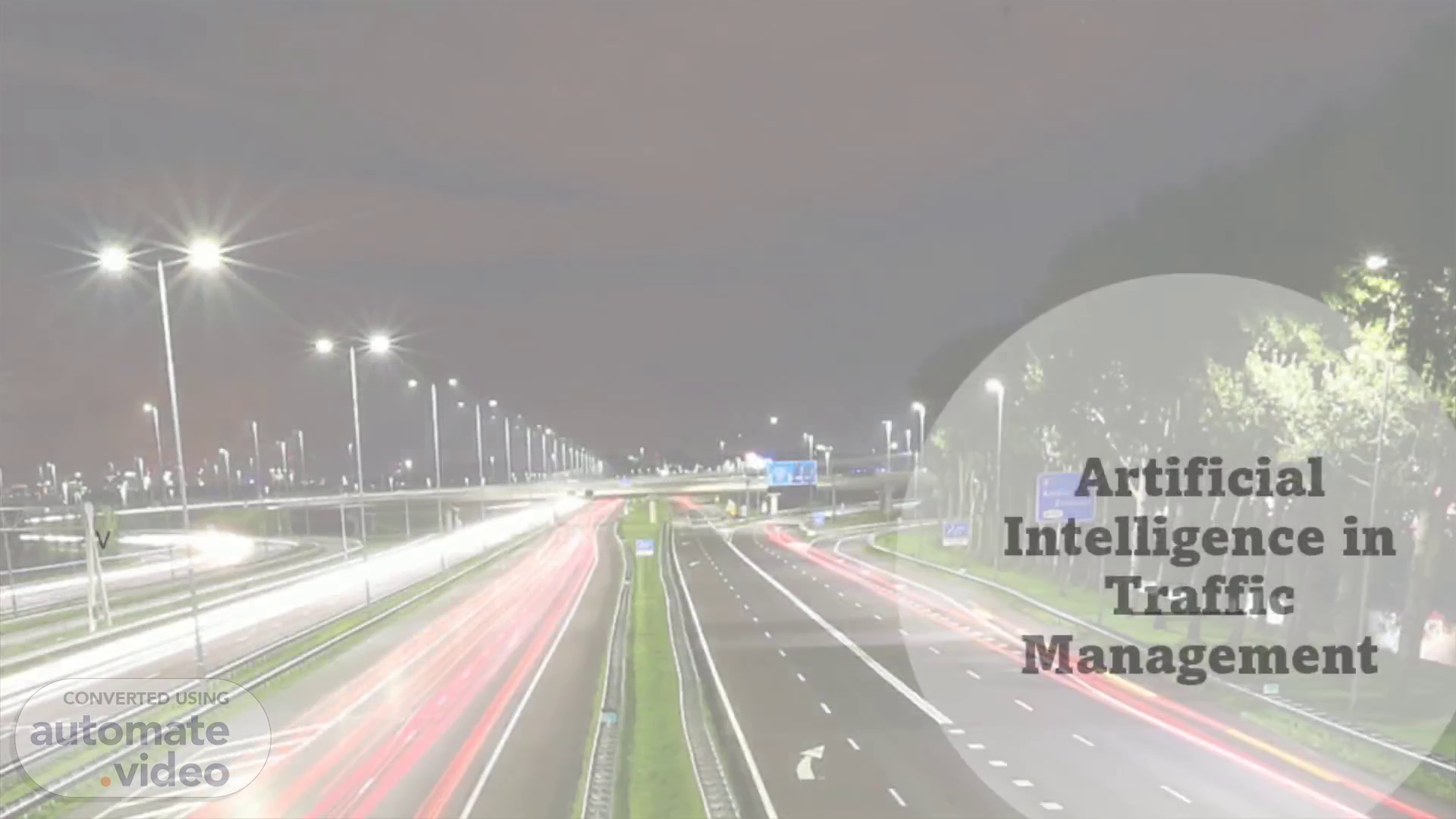
Artificial Intelligence in Traffic Management
Scene 1 (0s)
[Audio] Hello everyone, welcome to AI in traffic management..
Scene 2 (7s)
Traffic Management & Control. Millions of cars pass through a large city every day. This of course results in a large amount of traffic congestion and air pollution from engine emissions. One approach cities have taken to try and reduce traffic congestion is the installation of smart traffic signal control systems. These systems are designed to reduce congestion through smarter control of when traffic lights should be green or red. By using a computer to control traffic signals, congestion can be reduced..
Scene 3 (29s)
Problem. Traffic congestion in urban road networks is a substantial problem, resulting in significant costs for drivers through wasted time and fuel, detrimental impact to the environment due to increased vehicle emissions. One of the largest recurring sources of traffic congestion are poorly timed traffic signals. Even when signals have been recently retimed, the inability to respond to current traffic patterns can cause pockets of congestion that lead to larger traffic jams. Inefficiencies in traffic signal timing stem from poor allocation of green time, inability to respond to real-time conditions, and poor coordination between adjacent intersections. Controlling traffic lights and optimizing intersections can lead to proper traffic management and control. AI can be used to control adaptive traffic lights with the hep of existing infrastructure. AI algorithms can be used to determine when traffic lights turn green and for how long they remain green in areas with multiple intersections..
Scene 4 (1m 7s)
AI Solution - SURTAC. SURTRAC is a system that plans the control of traffic lights for a specific intersection based on information regarding approaching vehicles. SURTRAC uses cameras to detect approaching vehicles. The information from an intersection is then communicated to intersections in the vicinity, so that it can be used during planning. SURTRAC uses AI-based planning and scheduling. It can be seen as an 'online' controller that constantly optimizes itself as new information comes in. SURTRAC is a multiagent system, in which multiple autonomous agents exhibit smart behavior and cooperate. This is a field at the intersection between artificial intelligence, optimization, and operations research..
Scene 5 (1m 35s)
Proposed Solution. The Most Advanced Way to Do Traffic Signal Control surtrac is a decentralized A1 system that treats the intersection control challenge in a whole new way — as a single machine scheduling problem that optimizes each intersection and then shares information with neighbor intersections to create coordination and control across whole networks. • • • • • Real-time Response to Actual Traffic Surtrac optimizes every second based on actual traffic flows Decentralized & Inherently Scalable Surtrac is decentralized and scalable to networks of any size & shape Optimized for Complex Grids, Not Just Corridors While Surtrac is capable of handling suburban corridors with a single dominant flow, it really shines when optimizing more complex grid networks with multiple competing flows that change throughout the day Multi-modal optimization With advanced sensing, surtrac can integrate vehicle, pedestrian, bus, and bicycle traffic flows according to pre-specified priorities Integrated with connected vehicles Surtrac exploits more accurate connected vehicle data and can use it to enhance mobility.
Scene 6 (2m 10s)
System Diagram. SURTRAC (Scalable Urban Traffic Control) implements schedule-driven traffic control as part of a flexible signal control system that is designed to be easily integrated with controller and sensor hardware from any vendor..
Scene 7 (2m 23s)
CHARACTERISTICS of SURTAC. Decision Making Decentralized control system. Easy to integrate with any traffic signal controller. No centralized computational bottleneck. No single point of failure. Scalability & Adaptability: It promotes scalability by allowing incremental addition of intersections over time with minimal change to the existing adaptive network. Emphasis on real-time responsiveness to changing traffic conditions..
Scene 8 (2m 41s)
Benefits. travel time 400/0 less time waiting fewer harmful emissions Intelligent Traffic Signal Control • optimize for multiple modes of travel, keeping vehicles, cyclists, pedestrians, and transit moving and safe • Get people to their destinations 25% faster by eliminating stops, reducing wait tirne, and increasing travel speeds. Spend over 40% less time waiting at intersections. • Make 30-40% fewer stops, decreasing wear on the road and tires and resulting in a cost savings for drivers and cities- • Produce 20% fewer harmful emissions and improve air quality by reducing stops and idling..
Scene 9 (3m 6s)
Drawbacks. SURTRAC was designed for dense urban traffic centers. There could be a chance it would not perform as well or that better options exist in less congestion areas. The decentralized nature of SURTRAC can potentially make it difficult to find out problems as opposed to a large, centralized network. A suboptimal performance of an intersection could be masked by the fact that it is just one node of many. There could be potential problems that arise out of the decentralized nature of the system. While neighboring nodes can communicate with one another, each intersection only really knows about its own area. This means it cannot see the big picture and make short sighted signaling decisions that might not be the most beneficial..
Scene 10 (3m 37s)
SCOPE OF IMPROVEMENT. Improvements to SURTRAC are ongoing, including dynamic phase sequencing, which was not allowed as part of the pilot, improved service times for pedestrian calls, and bus detection and prioritization. An expansion of the pilot site to include nine more intersections is currently in progress, and further expansions are also planned. Bike and pedestrian options can be added to SURTRAC which could reduce travel times as well..
Scene 11 (3m 58s)
Examples of similar applications. There are many systems like SURTRAC that have been tested and installed all around the world. A few examples include SCATS in Sydney, Australia and Sierra Transportation Technologies in the United States..
Scene 12 (4m 11s)
Conclusion.
Scene 13 (4m 17s)
References. https://miovision.com/surtrac https://www.ri.cmu.edu/pub_files/2013/1/13-0315.pdf https://nacto.org/docs/usdg/smart_urban_signal_networks_smith.pdf https://medium.com/digitalshroud/surtrac-smart-traffic-system-b02082e9e839.
Scene 14 (4m 35s)
Thank You.